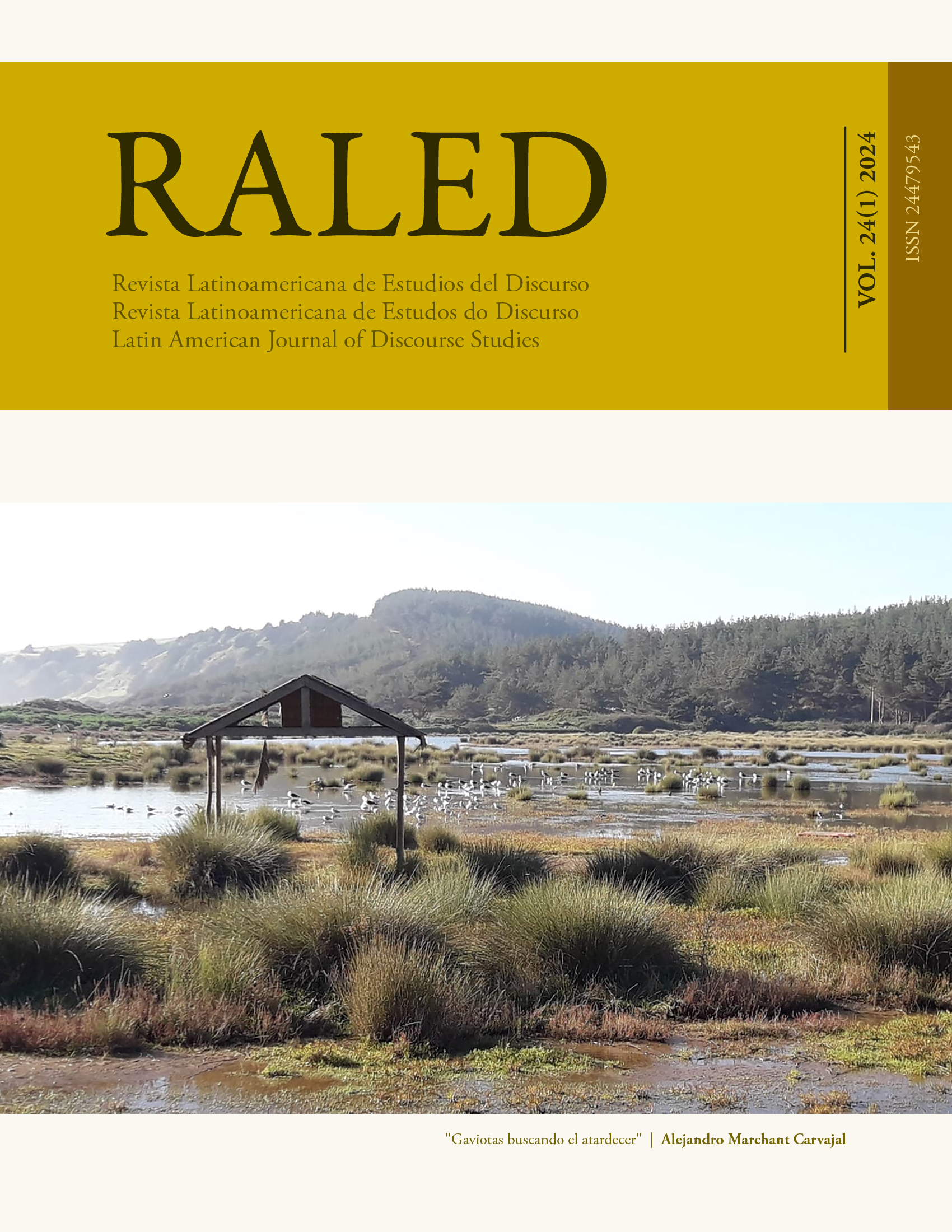Media representations of the Chilean press on Facebook for the constituent process
DOI:
https://doi.org/10.35956/v.24.n1.2024.p.66-85Keywords:
Chilean constitutional process, Disinformation, Facebook, Critical Discourse Studies, Latent Dirichlet AllocationAbstract
The study analyses media representations of the Chilean Constitutional process on Facebook. We crawled a corpus of 56,410 news reports from 145 Chilean media outlets published on Facebook from 18 October 2019 to 05 January 2022, which were then divided into four sub-corpora based on key milestones of the Constitutional process. First, each sub-corpus was analysed using SpaCy and Latent Dirichlet Allocation to identify relevant clusters, people, and entities. Then, we analysed the posts with which users interacted the most (25 posts per sub-corpus) following the Discourse-Historical Approach. Results show that each sub-corpus resorts to different framing strategies which evidence the strong monopolisation of the Chilean media and its tendency to criminalise social protests and new understandings of political and democratic practises through spectacle and moral panic frames.
Downloads
References
Alarcón Silva, M. y Cárdenas-Neira, C. 2021. Convocatoria de protesta a través de Instagram, un análisis socio cognitivo de estrategias discursivas en el contexto del movimiento social en Chile (2019-2020). Revista Latina de Comunicación, 79: 127–149. https://doi.org/10.4185/ RLCS-2021-1524
Bartley, L. e Hidalgo-Tenorio, E. 2016. “To be Irish, gay, and on the outside”: A critical discourse analysis of the other after the Celtic Tiger period. Journal of Language and Sexuality,5(1): 1–36. https://doi.org/https://doi.org/10.1075/jls.5.1.01bar
Berendt, B., Karadeniz, Ö., Mertens, S. y D’Haenens, L. 2021. Fairness beyond “equal”: The diversity searcher as a tool to detect and enhance the representation of socio-political actors in news media. Web Conf. 2021 - Companion world wide web conference. https://doi. org/10.1145/3442442.3452303
Blei, D., NG, A., Jordan, M. 2003. Latent Dirichlet Allocation. Journal of machine Learning research, 3: 993–1022.
Cárdenas-Neira, C. y Pérez-Arredondo, C. 2021. Prácticas discursivas insurgentes y ocupación de espacios urbanos: Análisis de los paisajes semióticos creados en dos ciudades de Chile du- rante la revuelta social (2019–2020). Bulletin of Spanish Studies, 98, 7: 1165-1190.
Cohen, S. 2011. Folk devils and moral panics: The creation of the Mods and Rockers (1972-2002). En C. Greer (Ed) Crime and media. Pp. 80-100. Routledge. https://doi.org/10.4324/9780367809195
De la Garza-Montemayor, D., Peña-Ramos, J. y Recuero-López, F. 2019. Online political participation of young people in Mexico, Spain and Chile. [La participación política online de los jóvenes en México, España y Chile]. Comunicar, 61: 83-92. https://doi.org/10.3916/C61-2019-07
Douglas, K.M., Uscinski, J.E., Sutton, R.M., Cichocka, A., Nefes, T., Ang, C.S. y Deravi, F. 2019. Understanding conspiracy theories. Political psychology, 4: 3–35. https://doi. org/10.1111/POPS.12568
Goffman, E. 1984. Frame analysis: An essay on the organisation of experience. Northeastern University Press. https://psycnet.apa.org/record/1975-09476-000
Hertog, J. K. y McLeod, D. M. 1995. Anarchists wreak havoc in downtown Minneapolis: A multilevel study of media coverage of radical protest. Journalism and Mass Communication Monographs, 151: 1–48. https://bit.ly/3A5bxq6
Ilustrado. 2021. [Disponible en línea en https://bit.ly/3zGSktm] Canal 13 responde a tuitero que ninguneo a Elisa Loncón por decir que «no sabe leer ni escribir». Ilustrado.cl
Just, S. N. 2009. No place like home? The role of the media in the framing of Europe. Journal of Language and Politics. 8, 2: 244–268. https://doi.org/https://doi.org/10.1075/jlp.8.2.04jus
Kilgo, D.K., Harlow, S., García-Perdomo, V. y Salaverría, R. 2018. From #Ferguson to #Ayotzinapa: Analyzing Differences in Domestic and Foreign Protest News Shared on Social Media. Mass Communication and Society, 21,5: 606-630, https://doi.org/10.1080/15205436.2018.1469773
Krzyżanowski, M. y Oberhuber, F. 2007. (Un)Doing Europe: Discourses and practices of negotiating the EU Constitution. P.I.E. Peter Lang, Brussels. https://bit.ly/3P9q0po
Lakoff, G. y Johnson, M. 1980. Metaphors we live by. The University of Chicago Press. https:// bit.ly/3p3kM3R
Lazzarato, M. 2009. Neoliberalism in Action: Inequality, Insecurity and the Reconstitution of the Social. Theory, Culture & Society, 26, 6: 109–133. https://doi.org/10.1177/0263276409350283
Mellado, C., Cárcamo-Ulloa, L., Alfaro, A., Inai, D., y Isbej, J. 2021. Fuentes informativas en tiempos de Covid-19: Cómo los medios en Chile narraron la pandemia a través de sus redes sociales. Profesional De La Información, 30, 4. https://doi.org/10.3145/epi.2021.jul.21
Moraes, M.P., de Oliveira Sampaio, J. y Charles, A.C. 2019. Data mining applied in fake news classification through textual patterns. Proceeding 25th brazillian symposium multimedia web, WebMedia 2019. https://doi.org/10.1145/3323503.3360648
Oberhuber, F., Bärenreuter, C., Krzyżanowski, M., Schönbauer, H. y Wodak, R. 2005. Debating the European constitution: On representations of Europe/the EU IN THE PRESS. s.f. Journal of Language and Politics, 4, 2: 227-271. https://doi.org/https://doi.org/10.1075/jlp.4.2.05obe
Reisigl, M. y Wodak, R. 2001. Discourse and discrimination: Rhetorics of racism and antisemitism. Routledge. https://doi.org/10.4324/9780203993712
Riffo-Pavón, I., Basulto, Ó. y Segovia, P. 2021. El Estallido Social chileno de 2019: un estudio a partir de las representaciones e imaginarios sociales en la prensa. Revista mexicana de ciencias políticas y sociales, 66, 243 https://doi.org/10.22201/FCPYS.2448492XE.2021.243.78095
Santander, P. 2021. [Disponible en línea en https://bit.ly/3P5aXwV]. "La Convención Constitucional está bajo ataque”, ¿verdad o fake news? Ciper Chile.
Tully, J. 2002. The unfreedom of the moderns in comparison to their ideals of constitutional democracy. Modern Law Review, 65, 2: 204–228. https://doi.org/10.1111/1468-2230.00375
Van Leeuwen, T. 2008. Discourse and Practice. Oxford University Press. https://bit.ly/3QxSJoC
We Are Social. 2022. Digital 2022: Another year of bumper growth. https://bit.ly/3vRq7Pl
Wodak, R. 2009. The discourse of politics in action: Politics as usual. Palgrave Macmillan. https://bit.ly/3p3ikdw
Wodak, R. y Meyer, M. (eds.) 2016. Methods of Critical Discourse Studies. Londres: Sage.
Downloads
Published
How to Cite
Issue
Section
License
Copyright (c) 2024 Carolina Pérez-Arredondo, Luis Cárcamo-Ulloa

This work is licensed under a Creative Commons Attribution-NonCommercial-NoDerivatives 4.0 International License.
The authors retain the copyright and guarantee RALED the right to be the first publication of the work as well as a Creative Commons Attribution License that allows others to share the work with recognition of authorship and the initial publication in this journal.




